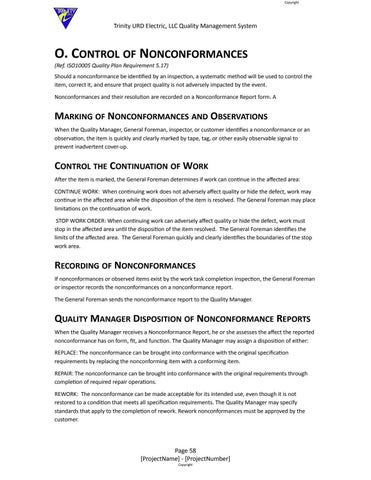Copyright
Trinity URD Electric, LLC Quality Management System
O. CONTROL OF NONCONFORMANCES (Ref. ISO10005 Quality Plan Requirement 5.17)
Should a nonconformance be identified by an inspection, a systematic method will be used to control the item, correct it, and ensure that project quality is not adversely impacted by the event. Nonconformances and their resolution are recorded on a Nonconformance Report form. A
MARKING OF NONCONFORMANCES AND OBSERVATIONS When the Quality Manager, General Foreman, inspector, or customer identifies a nonconformance or an observation, the item is quickly and clearly marked by tape, tag, or other easily observable signal to prevent inadvertent cover-up.
CONTROL THE CONTINUATION OF WORK After the item is marked, the General Foreman determines if work can continue in the affected area: CONTINUE WORK: When continuing work does not adversely affect quality or hide the defect, work may continue in the affected area while the disposition of the item is resolved. The General Foreman may place limitations on the continuation of work. STOP WORK ORDER: When continuing work can adversely affect quality or hide the defect, work must stop in the affected area until the disposition of the item resolved. The General Foreman identifies the limits of the affected area. The General Foreman quickly and clearly identifies the boundaries of the stop work area.
RECORDING OF NONCONFORMANCES If nonconformances or observed items exist by the work task completion inspection, the General Foreman or inspector records the nonconformances on a nonconformance report. The General Foreman sends the nonconformance report to the Quality Manager.
QUALITY MANAGER DISPOSITION OF NONCONFORMANCE REPORTS When the Quality Manager receives a Nonconformance Report, he or she assesses the affect the reported nonconformance has on form, fit, and function. The Quality Manager may assign a disposition of either: REPLACE: The nonconformance can be brought into conformance with the original specification requirements by replacing the nonconforming item with a conforming item. REPAIR: The nonconformance can be brought into conformance with the original requirements through completion of required repair operations. REWORK: The nonconformance can be made acceptable for its intended use, even though it is not restored to a condition that meets all specification requirements. The Quality Manager may specify standards that apply to the completion of rework. Rework nonconformances must be approved by the customer.
Page 58 [ProjectName] - [ProjectNumber] Copyright

